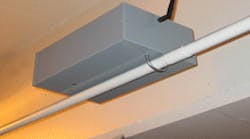Edited by Robert Repas Key points Resources Parallax Inc., www.parallax.com UCLA Center for Embedded Networked Sensing, www.ucla.edu "Passive Infrared Sensors," |
Most systems that monitor parking- lot occupancy are installed when the parking structure is built. But there are many existing structures that could benefit from an occupancy- monitoring system. However, retrofitting these existing structures is complex and expensive.
Such was the task facing a team from the UCLA Center for Embedded Networked Sensing trying to bring occupancy monitoring to a UCLA medical-building parking garage. They wanted to link an online database with the monitoring system to provide parking information locally and remotely.
The system helps lot patrons find parking and also provides data that aids parking administrators in managing their lots. The initial test site was a level of the UCLA medical building parking lot already subdivided into two zones, one for patients only and another for staff and patients.
Logistics made a wired solution impractical. The wireless sensor network used instead came from National Instruments Corp. (NI), Austin, Tex. Sensors installed at each entrance, exit, and transition points between the zones transmit data on vehicles entering and exiting the different zones to a central base station in the exit kiosk. The base station uses the data to give a real-time count of total parking available in each zone.
The primary vehicle traffic detectors are passive infrared (PIR) sensors from Parallax Inc., Rocklin, Calif. These sensors detect changes in the infrared black-body radiation emitted by objects and need little power because the sensing element generates its own electricity, turning infrared thermal energy into electrical current. They also provide a digital output that can be configured to put out pulses during motion detection, or remain high in the presence of continued motion and drop to low after reaching equilibrium.
Three NI WSN-3202 analog input nodes are each equipped with four analog voltage inputs and four digital I/O. The PIR sensor connects to a digital input while the sensor batteries connect to an analog input to monitor power consumption. In addition, four AA batteries power the WSN nodes. The nodes locally compute entrance and exit events to limit radio transmissions to the base station. The node itself decides when a car has passed rather than sending raw data to a server for processing. Thus the node transmits messages only when it detects a car to maximize battery life.
An NI CompactRio cRIO-9014 embedded real-time controller, powered by an ac source, makes up the base station in one of the two exit kiosks. The base station connects via Ethernet to the UCLA transportation network. Because of UCLA transportation security policies, the data is inaccessible outside of this network. However, it is possible to access this back-end database server for storage.
The NI WSN-9791 Ethernet gateway facilitates communication between the CompactRio base station and the wireless sensor nodes. This gateway sits inside the exit kiosk adjacent to the kiosk housing the CompactRio controller. The station connects to the same network as CompactRIO.
Data from the CompactRio streams in real time to the data repository, a Web server that provides a user-friendly Web interface to download, browse, share, and organize data. In addition, the repository provides a Web service application layer used to develop customized Web pages for presenting parking lot information to computer and cell-phone users.
A typical sensor operation takes place as follows: First, the wireless sensor nodes sample data from the PIR modules. The node runs a custom virtual instrument (VI) programmed using the NI LabView Wireless Sensor Network (WSN) Module Pioneer. The VI makes use of the digital I/O notification feature in the WSN node. When the PIR module detects motion, the WSN node triggers notification and continues to sample the digital input until it drops back to low.
After an event is detected, the WSN node sends a radio message back to the CompactRio base station signaling the event and its length of time. The digital I/O notification system and low-rate analog sampling minimize the amount of time the WSN nodes must stay up to send data.
The pulse-length data from the WSN nodes goes to the CompactRio base station and is categorized by how long it took the object to pass the sensor. This helps determine if one or more cars passed or if the sensor saw a pedestrian. The CompactRio keeps an internal count of the total number of cars in the parking garage. After each exit or entrance event, the event data and total count are logged internally to a file in the CompactRio flash storage and uploaded to the data repository.
Users can get a total count of cars currently in the parking garage through the data repository Web interface. The same Web services also graph the data and send it to cell phones as individuals drive from point-to-point. Future plans call for the base stations to upload information as well as download data from other linked parking lots to help users choose another parking facility if theirs is full. In addition, on-site signs can inform patrons of the parking situation at nearby lots.
